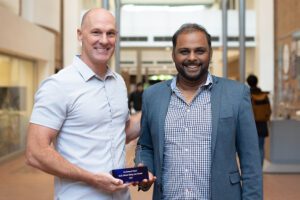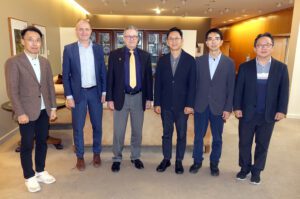Faisal, the 2023 ECE Rising Star Alumni Award recipient, founded Movellus based on his doctoral research conducted under Prof. David Wentzloff.


Faisal, the 2023 ECE Rising Star Alumni Award recipient, founded Movellus based on his doctoral research conducted under Prof. David Wentzloff.
An effort led by U-M could enable industrial competitors to collectively build a predictive model that speeds the development of advanced solar cells.
The post $3M to boost state-of-the-art solar manufacturing appeared first on Michigan Engineering News.
The findings could enable engineers to more reliably manufacture next-gen materials by combining different nanocrystals.
The post Scientists observe composite superstructure growth from nanocrystals in real time appeared first on Michigan Engineering News.
The breakthrough opens the way for designing and building more complex structures.
The post Nanoparticle quasicrystal constructed with DNA appeared first on Michigan Engineering News.
The University of Michigan’s latest program to grow the microchip workforce aims to reach up to 600 participants a year.
The post Michigan Engineering to launch semiconductor training program as part of statewide effort appeared first on Michigan Engineering News.

A delegation from LG AI Research visited campus to review LG-funded projects in process and discuss future collaborations.
Touchscreens are everywhere but not built for everyone. A new device could help bridge that gap, helping users access ticket kiosks, restaurant menus and more.
The post New phone case provides workaround for inaccessible touchscreens appeared first on Michigan Engineering News.

The semiconductor-compatible technology is a million times faster than existing electronics and could give us access to an entire new world of quantum phenomena.
Using a simple and convenient touchscreen interface, the algorithm learns the assistance preferences of the wearer.
The post Choosing exoskeleton settings like a Pandora radio station appeared first on Michigan Engineering News.
The U.S. Department of Energy announced today that the Midwest Alliance for Clean Hydrogen is selected as regional clean hydrogen hub.
The post U-M’s MI-Hydrogen to participate in new Midwest hydrogen hub appeared first on Michigan Engineering News.